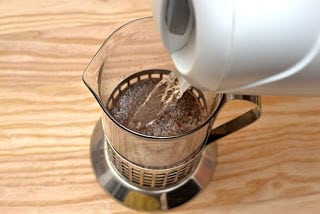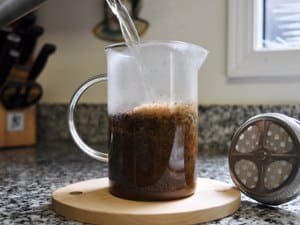I’m starting a series here on Top Off My Coffee where I discuss all the various aspects of making good French press coffee. I’ll be handling a lot of the common questions and discussing a number of the points of discussion coffee snobs typically have and then in the near future I’ll be publishing a larger overview of making good French press coffee. Look for that in the weeks to come.
In the mean time I wanted to answer one of the most basic questions regarding French press coffee – how hot should the water be?
If you are new to making French press coffee then this is one of the most basic fundamentals to get down right after how much coffee grind should be used in a French press.
The answer is simple and easy to remember.
Take your water to a boil on a stove and then pour directly into the press pot.
Let me explain this point a little bit though. There are a few things to understand.
How Hot to Make Water for French Press Coffee

When making French press coffee one of the most common ways of prepping the water is to put it in a kettle or stove top pan and bring it to a boil. Don’t use a hot water reservoir on your coffee maker because it doesn’t get all the way up to boiling.
When you take boiling water off the burner and place it directly into your (room temperature) French press the water temp is usually just a shade over 200 degrees. The temperature of the walls of the french press will almost instantly bring the temp down to the 190s which is actually an optimal zone for brewing good coffee.
The reason this question comes up so much is that some people want to take short cuts and use scalding hot tap water or use water that comes from a reservoir water heater. I have a coffee pot with a hot water reservoir and it constantly keeps water hot at about 185 degrees. Some people have dedicated scalding hot hot water faucets on their sink but even these may not get up into the 190s.
For coffee to brew properly in a coffee maker or in a french press the temp really should be above 190 and close to 200 if possible. If you measure your method for drawing hot water and it’s not this hot then you really should reconsider bringing a pot of water to boil on the stove – it’s a sure thing every time.
Related – Check out the following posts to see my favorite insulated French presses and the largest French presses I’ve experimented with.
What Happens if you Make French Press Coffee With Water That Isn’t Hot Enough?

Now having said all that I should make one more point.
If your water is not hot enough nothing bad will happen. Your coffee grind will brew just fine – it just won’t taste as good as it should.
The flavors that extract from ground coffee beans come out best in the 190-195 degree zone. When the water temperature is lower than this then the bitters extract from the beans in greater proportion and the positive flavors extract in less significant quantities. You will still get your caffeinated jolt but the taste won’t be up to par.
Please take a little time to check out this post on the benefits of using insulated french press pots. The insulated pots maintain higher temperatures during the brewing process and also help to improve flavor of the coffee.
=====
How hot should the water be for French Press coffee
The French press is one of the easiest way to get fresh brewed coffee any time of the day. But do not be deceived by its simplicity. One wrong move with the French press can lead to a bad tasting coffee.
A good cup of French press coffee has to have a perfect balance of these elements:
- Coffee ground – It has to be coarse ground coffee that suits well for French press.
- Steeping time – Coffee grounds need to bloom for about 3 to 4 minutes to extract flavor and aroma.
- Water temperature – There is prescribed water temperature for French press coffee to achieve the perfect coffee blend.
All of these elements, when combined together, make a great tasting cup of French press coffee.
Perfect water temperature for French press
As a rule of thumb, coffee experts say that boiling water is not suitable for coffee. Aside from being too hot for the palate (you cannot really drink a freshly boiled water!), boiling water destroys that full body taste of coffee and replacing it with bitter, very tangy black liquid.
Since water temperature is very crucial in the brewing process, the National Coffee Association sets a prescribed temperature range to achieve the optimum brew. The ideal water temperature is between 195 degrees Fahrenheit to 205 degrees Fahrenheit.
Water’s boiling temperature is 212°F, and that range is actually in reference to the brew temperature — in other words, when the grounds and water are together.
For French press, the ideal water temperature should be between 195 degrees Fahrenheit to 200 degrees Fahrenheit. It is recommended to use a thermometer to measure the temperature. But in the absence of a kitchen thermometer, a boiling water can be cooled down for 30 seconds to reduce temperature to the optimum level suited for French press.
Why should you bother with water temperature?
Well, you can easily pour hot water on your French press. Only, the end product will not resemble anything like fresh brewed coffee. It would be more like bitter, burnt black liquid.
The secret to getting the perfect bittersweet drink lies in extraction. For extraction to happen, water is needed. Water is pushed through the coffee grounds and it extracts the flavor, taste and aroma.
However, it’s not just about any water. To extract coffee, an optimum water temperature is needed.
- When water is too hot – Many people make the mistake of using freshly boiled water. When you do this, over-extraction may occur. It will make coffee bitter and burnt.
- When water is cold – This results to under-extraction. It will make coffee weak and taste sour.
- When water is just right – You get a cup of coffee that’s hot enough to drink, full body and aromatic.
How to make French press coffee
Here is a step-by-step guide on how to make the perfect French press coffee brew:
- Pre-heat the carafe. Pour boiling hot water in the carafe. Warm up the French press. This will help maintain the temperature of the hot water that you will pour in. You can skip this step and pour in the hot water. But, this will significantly drop the temperature of the water. If it goes below 195 degrees Fahrenheit, then you still have to steep the coffee grounds, your final product will be around 180 degrees Fahrenheit. This is already warm and can make your coffee stale.
- Weigh your coffee. There is no one golden standard but you need to keep the right ratio to achieve the taste and flavor you love. The pro tip is that you start with 8 grams or about 1 tablespoon of coarse ground coffee per 4 oz of water or roughly a cup of water. Add more if you want a stronger and bolder taste, or if you want to create an espresso alternative. You can also reduce this amount if you want a lighter coffee. Since French press come in different sizes, here is a guide for each type:
- 3-cup size: 12 oz French press needs 16-24 grams or 2 to 3 tablespoons of coffee grounds
- 5 cup size: 20 oz French press needs 32 to 40 grams or 4 to 5 tablespoons of coffee grounds
- 8-cup size: 34 oz French press needs 56 to 64 grams or 7 to 8 tablespoons of coffee grounds
- Boil water. But never pour this immediately on the coffee grounds. Let it cool for at least 30 seconds to reduce the temperature from boiling point. Freshly boiled water is at 212 degrees Fahrenheit. It’s too hot for coffee and scalding to drink. Let it cool down at least 205 degrees Fahrenheit.
- Grind coffee beans. While the water is boiling, grind your coffee beans. Coarse ground is the most recommended for French press. Aroma from coffee beans diminish after grinding. If you often use French press, invest in a manual burr grinder to get freshly brewed coffee all the time.
- Place the coffee grounds in the carafe. Add the hot water. Place the lid with the plunger to lock in the heat. Steep the coffee grounds for four minutes. This will ensure that the coffee grounds bloom.
- Slowly press down the plunger. Do not rush this process. Just keep a steady pressure to ensure that you extract the coffee in a consistent fashion.
- Pour the coffee in your cup. If you have an insulated travel mug, pour it there and enjoy brewed coffee for up to 6 hours.
